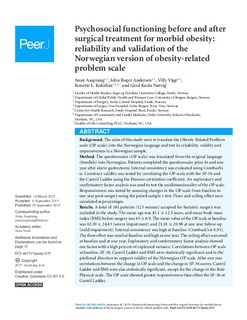| dc.contributor.author | Aasprang, Anny | |
| dc.contributor.author | Andersen, John Roger | |
| dc.contributor.author | Våge, Villy | |
| dc.contributor.author | Kolotkin, Ronette L. | |
| dc.contributor.author | Natvig, Gerd Karin | |
| dc.date.accessioned | 2016-02-01T14:32:50Z | |
| dc.date.available | 2016-02-01T14:32:50Z | |
| dc.date.issued | 2015 | |
| dc.identifier.citation | Aasprang, A., Andersen, J., Våge, V., Kolotkin, R., & Natvig, G. (2015). Psychosocial functioning before and after surgical treatment for morbid obesity: Reliability and validation of the Norwegian version of obesity-related problem scale. PeerJ, 3, E1275. | nb_NO |
| dc.identifier.issn | 2167-8359 | |
| dc.identifier.uri | http://hdl.handle.net/11250/2375568 | |
| dc.description.abstract | Background. The aims of this study were to translate the Obesity-Related Problem
scale (OP scale) into the Norwegian language and test its reliability, validity and
responsiveness in a Norwegian sample.
Method. The questionnaire (OP scale) was translated from the original language
(Swedish) into Norwegian. Patients completed the questionnaire prior to and one
year after sleeve gastrectomy. Internal consistency was evaluated using Cronbach’s
α. Construct validity was tested by correlating the OP-scale with the SF-36 and
the Cantril Ladder using the Pearson correlation coefficient. An exploratory and
confirmatory factor analysis was used to test the unidimensionality of the OP scale.
Responsiveness was tested by assessing changes in the OP scale from baseline to
one year post-surgery using the paired sample t-test. Floor and ceiling effect were
calculated as percentages.
Results. A total of 181 patients (123 women) accepted for bariatric surgery was
included in the study. The mean age was 43.1 ± 12.5 years, and mean body mass
index (BMI) before surgery was 45 ± 6.9. The mean value of the OP scale at baseline
was 63.30 ± 24.43 (severe impairment) and 21.01 ± 20.98 at one year follow-up
(mild impairment). Internal consistency was high at baseline (Cronbach’s α 0.91).
The floor effect was small at baseline and high at one year. The ceiling effect was small
at baseline and at one year. Exploratory and conformatory factor analysis showed
one factor with a high percent of explained variance. Correlations between OP scale
at baseline, SF-36, Cantril Ladder and BMI were statistically significant and in the
predicted direction to support validity of the Norwegian OP scale. After one year
correlations between the change in OP scale and the change in SF-36 scores, Cantril
Ladder and BMI were also statistically significant, except for the change in the Role
Physical-scale. The OP scale showed greater responsiveness than either the SF-36 or
Cantril Ladder.
Conclusion. These results confirm that the Norwegian version of the OP scale is a
valid and reliable instrument for measuring psychosocial functioning in patients with
clinically severe obesity. | nb_NO |
| dc.language.iso | eng | nb_NO |
| dc.publisher | PeerJ | nb_NO |
| dc.rights | Navngivelse 3.0 Norge | * |
| dc.rights.uri | http://creativecommons.org/licenses/by/3.0/no/ | * |
| dc.subject | obesity | nb_NO |
| dc.subject | obesity surgery | nb_NO |
| dc.subject | quality of life | nb_NO |
| dc.subject | OP-scale | nb_NO |
| dc.subject | Psychosocial functioning | nb_NO |
| dc.subject | validity | nb_NO |
| dc.subject | reliability | nb_NO |
| dc.subject | Questionnaires | nb_NO |
| dc.title | Psychosocial functioning before and after surgical treatment for morbid obesity: reliability and validation of the Norwegian version of obesity-related problem scale | nb_NO |
| dc.type | Journal article | nb_NO |
| dc.type | Peer reviewed | nb_NO |
| dc.source.pagenumber | 14 | nb_NO |
| dc.source.journal | PeerJ | nb_NO |
| dc.identifier.doi | 10.7717/peerj.1275 | |
| dc.identifier.cristin | 1289985 | |

